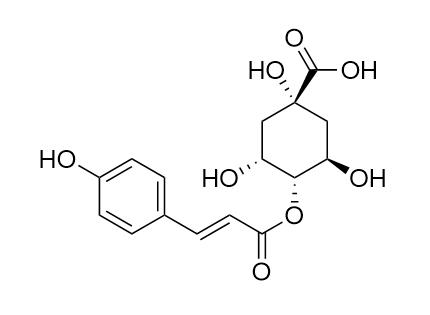4-O-Coumaroylquinic acid
4-O-Coumaroylquinic acid has potential inhibitory capacity on the spike glycoprotein trimer of SARS-CoV-2.4-O-Coumaroylquinic acid has inhibitory activity against LdNH.4-O-Coumaroylquinic acid has certain antioxidant capacity.
Inquire / Order:
manager@chemfaces.com
Technical Inquiries:
service@chemfaces.com
Tel:
+86-27-84237783
Fax:
+86-27-84254680
Address:
1 Building, No. 83, CheCheng Rd., Wuhan Economic and Technological Development Zone, Wuhan, Hubei 430056, PRC
Providing storage is as stated on the product vial and the vial is kept tightly sealed, the product can be stored for up to
24 months(2-8C).
Wherever possible, you should prepare and use solutions on the same day. However, if you need to make up stock solutions in advance, we recommend that you store the solution as aliquots in tightly sealed vials at -20C. Generally, these will be useable for up to two weeks. Before use, and prior to opening the vial we recommend that you allow your product to equilibrate to room temperature for at least 1 hour.
Need more advice on solubility, usage and handling? Please email to: service@chemfaces.com
The packaging of the product may have turned upside down during transportation, resulting in the natural compounds adhering to the neck or cap of the vial. take the vial out of its packaging and gently shake to let the compounds fall to the bottom of the vial. for liquid products, centrifuge at 200-500 RPM to gather the liquid at the bottom of the vial. try to avoid loss or contamination during handling.
Heliyon.2023, 9:e21652.
Journal of Functional Foods2022, 91:105019.
Prev Nutr Food Sci.2024, 29(4):504-511.
Pathol Res Pract.2024, :260:155445.
Pharmacogn Mag.2015, 11(43):562-6
Eur J Pharmacol.2020, 889:173589.
J Pharm Pharmacol.2024, 76(10):1239-1268.
Antiviral Res.2013, 98(3):386-93
Research Square2021, March 3rd.
Food Sci Nutr.2023, 00:1-10.
Related and Featured Products
Eur J Nutr . 2011 Oct;50(7):507-522.
Intestinal transit and systemic metabolism of apple polyphenols[Pubmed:
21184087]
Background: Apples are the most widely consumed fruits in Germany and various other countries. Positive health effects of apple-derived polyphenols in vivo depend on their absorption, metabolism, distribution, and elimination from the body after consumption. Data on the metabolism of these polyphenols in humans are scarce. In order to study the intestinal transit and metabolism of apple polyphenols in humans, a variety of experiments were carried out.
Methods: Polyphenols were incubated with saliva (for 5 min), simulated gastric or duodenal juice (4 or 10 h, respectively), or rat hepatocytes (4 h) under aerobic conditions, and with ileostomy fluid under aerobic conditions for 10 h. The polyphenol profile in human serum (8 h later) and renal elimination in urine (24 h later) were also investigated after consumption of 1 L apple juice. Polyphenols and their metabolites were identified and quantified by high-performance liquid chromatography with diode array detection (HPLC-DAD), HPLC-electrospray ionization-tandem mass spectrometry (ESI-MS/MS), and gas chromatography (GC)-MS.
Results: In the presence of native saliva or ileostomy fluid, β-glycosides of phloretin and quercetin were hydrolyzed, to varying degrees depending on the sugar moiety, and to much lesser degrees in the presence of antibiotics. In the gastric milieu, almost complete degradation of procyanidin B(2) to (-)-epicatechin was observed. In the presence of artificial duodenal juice flavan-3-ol epimerization occurred. Quercetin was completely converted to phloroglucinol, 3,4-dihydroxybenzoic acid, and 2,4,6-trihydroxybenzoic acid. Formation of isomeric products of hydroxycinnamic acid esters and their corresponding methyl esters was also observed, and similar results were obtained after incubation with rat hepatocytes. Products of phase II metabolism, two phloretin O-glucuronides and eight (methyl) quercetin O-glucuronides, were identified in the hepatocyte samples. Following enzymatic hydrolysis, 5-caffeoylquinic acid, 4-p-coumaroylquinic acid, caffeic acid, (-)-epicatechin, phloretin, and quercetin were recovered in both serum and urine (5.3% and 3.5% of the amounts consumed, respectively). In addition, 19.5% of the polyphenols consumed were identified in the urine in the form of hydroxylated phenolic and hippuric acids.
Conclusion: The findings relating to the absorption, metabolism, and systemic availability of polyphenols in vivo should contribute to our understanding of their biological effects, and the characterization of newly formed metabolites should facilitate further studies.
Food Chem . 2022 Mar 30;373(Pt B):131437
Phenolic compound profiles in Finnish apple (Malus × domestica Borkh.) juices and ciders fermented with Saccharomyces cerevisiae and Schizosaccharomyces pombe strains[Pubmed:
34749087]
The phenolic compounds in juices and ciders made with Saccharomyces cerevisiae or Schizosaccharomyces pombe from eleven Finnish apple cultivars were analyzed using liquid chromatographic and mass spectrometric methods combined with multivariate data analysis. In general, the ciders contained less phenolic compounds than corresponding apple juices. In the studied apple juices and ciders, hydroxycinnamic acids were the most predominant, accounting for around 80% of total phenolic compounds. Apple juices contained more flavonol glycosides and dihydrochalcones whereas cider processing resulted in increased amount of free hydroxycinnamic acids. The contents of individual phenolic compounds were more dependent on the apple cultivars than the yeast species. Certain cultivars contained remarkably higher contents of dihydrochalcones and hydroxycinnamic acids when comparing with other cultivars. Ciders made using S. pombe remained higher contents of procyanidins and (+)-catechin while S. cerevisiae ciders contained higher individual hydroxycinnamic acids, such as 5-O-caffeoylquinic acid, 4-O-caffeoylquinic acid, 3-O-p-coumaroylquinic acid, and 4-O-p-coumaroylquinic acid.



